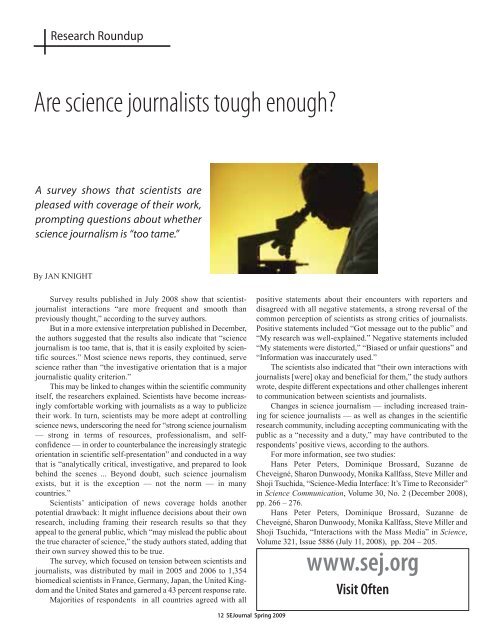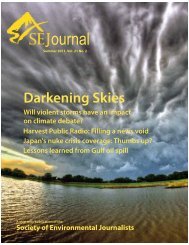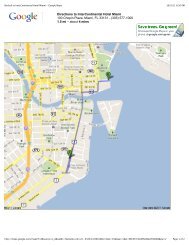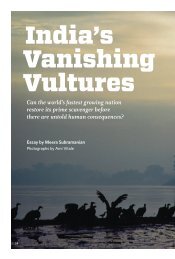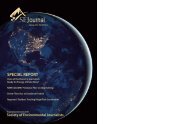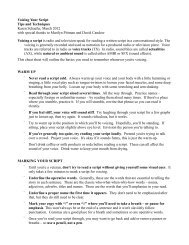Research RoundupAre science journalists tough enough?A survey shows that scientists arepleased with coverage <strong>of</strong> their work,prompting questions about whetherscience journalism is “too tame.”By JAN KNIGHTSurvey results published in July 2008 show that scientistjournalistinteractions “are more frequent and smooth thanpreviously thought,” according to the survey authors.But in a more extensive interpretation published in December,the authors suggested that the results also indicate that “sciencejournalism is too tame, that is, that it is easily exploited by scientificsources.” Most science news reports, they continued, servescience rather than “the investigative orientation that is a majorjournalistic quality criterion.”This may be linked to changes within the scientific communityitself, the researchers explained. Scientists have become increasinglycomfortable working with journalists as a way to publicizetheir work. In turn, scientists may be more adept at controllingscience news, underscoring the need for “strong science journalism— strong in terms <strong>of</strong> resources, pr<strong>of</strong>essionalism, and selfconfidence— in order to counterbalance the increasingly strategicorientation in scientific self-presentation” and conducted in a waythat is “analytically critical, investigative, and prepared to lookbehind the scenes ... Beyond doubt, such science journalismexists, but it is the exception — not the norm — in manycountries.”Scientists’ anticipation <strong>of</strong> news coverage holds anotherpotential drawback: It might influence decisions about their ownresearch, including framing their research results so that theyappeal to the general public, which “may mislead the public aboutthe true character <strong>of</strong> science,” the study authors stated, adding thattheir own survey showed this to be true.The survey, which focused on tension between scientists andjournalists, was distributed by mail in 2005 and 2006 to 1,354biomedical scientists in France, Germany, Japan, the United Kingdomand the United States and garnered a 43 percent response rate.Majorities <strong>of</strong> respondents in all countries agreed with allpositive statements about their encounters with reporters anddisagreed with all negative statements, a strong reversal <strong>of</strong> thecommon perception <strong>of</strong> scientists as strong critics <strong>of</strong> journalists.Positive statements included “Got message out to the public” and“My research was well-explained.” Negative statements included“My statements were distorted,” “Biased or unfair questions” and“Information was inaccurately used.”The scientists also indicated that “their own interactions withjournalists [were] okay and beneficial for them,” the study authorswrote, despite different expectations and other challenges inherentto communication between scientists and journalists.Changes in science journalism — including increased trainingfor science journalists — as well as changes in the scientificresearch community, including accepting communicating with thepublic as a “necessity and a duty,” may have contributed to therespondents’ positive views, according to the authors.For more information, see two studies:Hans Peter Peters, Dominique Brossard, Suzanne deCheveigné, Sharon Dunwoody, Monika Kallfass, Steve Miller andShoji Tsuchida, “Science-Media Interface: It’s Time to Reconsider”in Science Communication, Volume 30, No. 2 (December 2008),pp. 266 – 276.Hans Peter Peters, Dominique Brossard, Suzanne deCheveigné, Sharon Dunwoody, Monika Kallfass, Steve Miller andShoji Tsuchida, “Interactions with the Mass Media” in Science,Volume 321, Issue 5886 (July 11, 2008), pp. 204 – 205.www.sej.orgVisit Often12 SEJournal Spring 2009
Investigative journalists define crossing the lineInvestigative journalists usecomplex framing to draw theline between advocacy andobjectivity, study suggests.By JAN KNIGHTResearch suggests that the newsmedia block or transform “beyond recognition”the aims <strong>of</strong> environmental andother activist groups.But a recent study suggests otherwise.It concludes that investigative journalists<strong>of</strong>ten are activists, but they staywithin pr<strong>of</strong>essional boundaries.The research focused on two documentaries about the Danishchemical producer Cheminova’s distribution <strong>of</strong> pesticides illegalin Denmark to developing countries, where they were not prohibited.Each documentary — one aired in 1997, the other in 2006 —sparked immediate outcry and moral debate among Danishcitizens, including politicians and members <strong>of</strong> the public, unions,pension funds and the news media, and resulted in concessionsfrom Cheminova, according to the study.The researcher described investigative journalism as akin toscientific research — that is, aiming to be objective, accurate andthorough — except that it is “more political” than science in topicselection and framing, a trait linked to its emphasis on serving asa watchdog <strong>of</strong> neglect and abuse.Each documentary was reported by a freelance journalist whohad founded his own independent media company and, duringtravels to developing countries, had observed pesticide use andwondered where the chemicals had been obtained. Each told theresearcher that their observations led to an effort to document theorigin, including using public records, and then they soughtfunding for their projects.For both journalists, the motivation for reporting the storywas the chemical company’s publicity, which stated that it wasoperating in socially and environmentally responsible ways,juxtaposed against empirical data, including their observations <strong>of</strong>unprotected farmworkers handling the pesticides. The reportersalso said they worried about crossing the line separating advocacyand investigative journalism, fearing to appear as judges <strong>of</strong> thecompany’s behavior.The researcher compared the documentaries to newspapercoverage <strong>of</strong> Cheminova to find that reports <strong>of</strong> pesticide exportsbegan immediately after the films aired and continued for one yearfor the 1997 documentary and six months for the 2006 documentary.In both cases, “the debate soon became a media storm,”including investigations by mainstream media.“The ability <strong>of</strong> the two documentariesand their investigative journalism tospark public debate and place an issueADVOCACYon the public agenda was undoubtedlyobserved by civil society organizations(CSOs) with envy,” the researcherstated. But, although investigativejournalists and activists each mustprovide credible evidence <strong>of</strong> theirOBJECTIVITY claims, “CSOs are more readilyaccepted as representing a certainpolitical position. This freedom is notgranted to journalism, not even its investigativevariant.”In each <strong>of</strong> the documentaries, complex framing took place asthe reporters tried to distance themselves from the problem as theysaw it — farmworkers’ handling <strong>of</strong> “highly toxic pesticides withoutproper knowledge and protection” — by placing moralresponsibility with the chemical company. The company had donenothing illegal but, “by juxtaposing the corporation’s publicformulations about responsibility with the empirical realities onthe ground” via audio and visual imagery, it became implicatedin the impacts <strong>of</strong> pesticide use on unwary farmworkers, theresearcher suggested. Supporting this frame was the chemicalcompany’s refusal to take part in the documentaries when asked,he added.In the debates that followed the documentaries’ airings,criticisms <strong>of</strong> the investigative approach arose, including eachfilm’s focus on negative aspects <strong>of</strong> pesticide use without examiningbenefits, including increasing crop yields and, in turn,increasing the standard <strong>of</strong> living for those in the countries wherethe pesticides were used.“Investigative journalists do frame their material in a criticaland activist-like manner,” the researcher concluded. This “onlybecomes a democratic problem under two conditions: If counterargumentsare excluded or drowned out in the debate that follows”and the reporting is inaccurate or illogical. In regard to the latterpoint, “it should always be open to debate whether concrete acts<strong>of</strong> journalism succeed,” he stated.For more information, see Thomas Olesen, “ActivistJournalism?” in Journalism Practice, Volume 2, No. 2 (December2008), pp. 266 – 276.13 SEJournal Spring 2009Jan Knight, a former magazine editor and daily newspaperreporter, is a former assistant pr<strong>of</strong>essor <strong>of</strong> communication atHawaii Pacific University in Honolulu, where she continues toteach online courses in writing and environmentalcommunication. She can be reached at jknight213@aol.com


